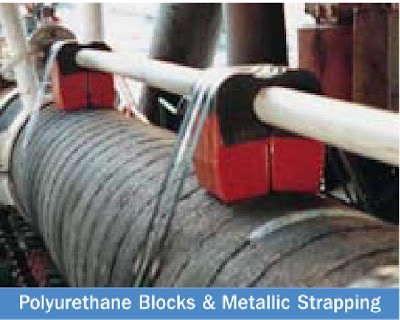ANCHOR HANDLING PROCEDURE
Anchor handling is the activities pertaining to mooring, relocating, adjusting, retrieving anchors on barges and workboats.
To handle an anchor, barge should be moored to the exact location with high concerned on the safety issue because the operation is potentially dangerous. To achieve this purpose, the whole move of the barge must methodically plan and prepared to obtain maximum efficiency and safety.
In the planning, things to be considered are the location of the work site, the water depth (whether the barge could attain that depth), type of bottom on location (normally soil), weather condition and approach course.
The anchoring process shall use the suitable type of anchor with enough holding power in the soil condition at the site. This selection will be considered based on the size of the barge.
Anchor pennant buoys are required for deployment and retrieval of anchors to identify the location of the anchor at the seabed. The buoy is painted with visible colour example day glow or international orange.

Anchor winches is the machine that provide the tension on the anchor wire during anchor deployment or relocation and as a machine to retrieve the anchors by reel-in the anchor wire. Anchor wire shall have adequate tension force to hold the anchors.
During the anchor handling process, communication is very crucial to avoid faultiness. Device such as walkie-talkie is commonly used by the crews.
SETTING AND ANCHORING OF ANCHOR
To choose the anchor, holding power is the main thing to be considered. Below is some calculation to determine the holding power:
FLUKE AREA (m²) x PENETRATION (m) = TONS (m³)
Then, the fluke or shank angle should be appropriate with the type of the seabed. Different soil needs different angle of fluke/shank. The principle will be explained below:
1. In hard soil, an anchor with a fluke angle of 32 degrees will give the highest holding power.
2. In hard soil, 50 degree fluke shank angle will obstruct penetration and the anchor will begin to trip, fall aside and slide along the seabed.
3. In mud, 32 degree fluke shank angle will not penetrate sufficiently.
STEVTENSIONER
Stevtensioner is used for tensioning anchor cables. This is the case when insufficient powerful equipment was installed or the installation of powerful equipment was too expensive.
The full anchor system will be tensioned before linking up and fully ready for the arrival of the floating object, vessel or buoy at the anchor location. Then, it is secured by immediate link-up.

The dead end of the passive chain is connected to the tensioner. The work chain, B is led through the tensioner.

PRINCIPLE:
· When pulling vertical direction on the work chain, tensioner will be lift up. The chain will experience the stretching.
· When no more stretching is possible, tensioner will be moved upward by the vertical force.
· The tensioner does not allow the chain to slide back, so the horizontal chains will drag the anchors into the soil. Consequently the holding power of the anchors increases.
MULTI TENSIONER

Multi tensioner will tension multiple anchor lines in the installation phase and offers permanent fixation of a web of anchor lines near the sea floor. Anchors, multi tensioner and sub-sea buoy have have been combined in a new cost effective alternative mooring. The advantages of the system are most evident in moorings in deep water. New applications have been described for the mooring of production and tension leg platforms with special attention paid to simple installation methods without the use of divers.
PRINCIPLE:
(Based on the development of the stevtensioner)
Multi-tensioner handles multiple lines and consists of one chain locking device per anchor line situated for instance on a ring (figure) or mounted like a Christmas tree around a vertical pipe member. The chain locking devices can also be attached to the base of a floating tower or ballast frame for a tension leg platform. To allow motion in the vertical plane they can be fixed on hinges.
MOORING LINES
Mooring systems are designed with sufficient strength to maintain a unit on location under all circumstances. The design calculations must accommodate conditions met in worst weather.
Commonly, most rigs were equipped with chains as mooring lines. In deep water, the mooring lines were replaced by composite mooring system because;
· The weight of the chain made handling impossible
· Once the mooring line was installed there was a very steep chain angle near the fairlead due to the chain’s weight. This rendered the movement of the rig unacceptable due to the wind and waves.
To solve this problem, a composite mooring system will be used.
Some suggestions which influence the catenary and consequently the forces in the mooring system are given below;
1) The buoy can be connected to the anchor line by means of a special permanent chain lock-chaser.

2) When using relatively long mooring lines in shallow waters, the effect of the rig movement on the systems can be optimized by applying a ballast weight within the system.

3) To optimize the chain or rig angle a combination of buoy and ballast permits a closer rig mooring.

BREAKING OUT FORCES
Breaking out forces is related to the holding power applied. If an anchor has not penetrated too deeply (thus giving a low holding efficiency) it can easily be broken out. Consequently, some users apply oversized anchors. However if an anchor has penetrated deeply and has been subjected to a high load, it will then be proportionally more difficult to break out.
Second factor influencing the forces required for breaking out is the design of the anchor.
The types of soil clearly influence breaking out forces, regardless of the anchor type.
· In sandy soils, the breaking out force is approximately 12-17% of the load held.
· In clay it is 60%
· In soft soils it will be even higher
· In sticky soils it can exceed 100%
(These approximations are applicable to any anchor type.)
















